Notes
Move Over Zarqawi: The New Iranian President And The 1979 Embassy Take-Over
The Administration would be happy for you to believe that the new president of Iran helped lead the take-over of the U.S. embassy in ’79. So would your own eyes.
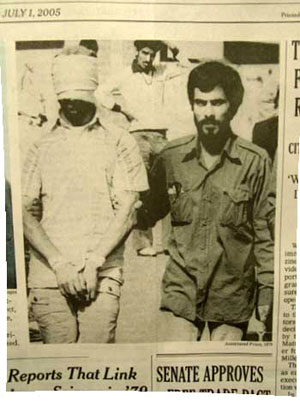
How much does the administration single-handedly create new evil-doers and how much does the press go along?
One thing the White House has been expert at is the personification of evil. To mask the neocon agenda and to direct attention away from failed policies and theories that don’t add up, they are masters at stoking fear and creating false urgency by building up bad guys. Sometimes though, the press can take a suggestion here or an innuendo there and conflate these figures on their own. We had a nice case study of this just last week.
With the election of hard-liner Mahmoud Ahmadinejad as the new President of Iran, images began circulating on the internet showing the takeover of the U.S. embassy in Tehran in 1979. Because of the likeness between one of the hostage takers and Mr. Ahmadinejad, the White House and several of the U.S. hostages — over denials from the Iranians — began implying they were one in the same.
For example, here’s an account by one hostage reported by the NYT:
Donald Sharer, of Bedford, Ind., said on NBC television that he
was virtually certain Mr. Ahmadinejad was the same man. He said he had
been reading the Indianapolis Star recently and saw a recent picture of
the president-elect."All of a sudden, up pops the devil, right in front of me," he said.
Mr. Sharer said he remembered, while being held in Tehran’s
notorious Evin prison, having the man he now believes to have been Mr.
Ahmadinejad come in and berate the prisoners as "pigs and dogs" in a
way that left him fearing for his life."You tend not to forget people that put your life in threat," he said.
As the story began to build, the Iranians
vigorously denied the charge. Although Mr. Ahmadinejad was part of the
student movement that helped spark the Iranian Revolution, officials
claimed he had nothing to do with the group that took over the
embassy. The rebuttal stated that the students involved were not
associated with the group from Mr. Ahmadinejad’s university.
I should say I’m not taking a position over whether the President-elect
was involved or not. The BAG’s interest is what politicians and the
press tends to do with these kinds of allegations.
To understand how easily these impressions are made, however, lets look at the previous Friday’s NYT. Here are the lead images spread across columns two through four above the headline "U.S. Pursuing Reports That Link Iranian To Embassy Seizure in ’79."
Notice that a current photo of Ahmadinejad is juxtaposed with an image
of the hostage taker. Presented this way, just the proximity —
combined with the power of suggestion — makes for a convincing case.
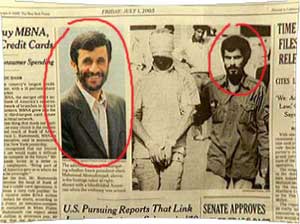
It’s only when you start considering other information, however, do
you realize how manipulative this cover is. For example, the Times
website happened to offer this image of the hostage taker below.
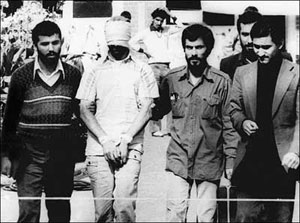
If you had only seen the front page of the print edition, you would
never realize that the cover version had been cropped. The effect
plays out on a number of levels. For example, the one-to-one
relationship between Ahmadinejad’s photo and the hostage taker makes it
easy (maybe even likely) to think that he’s the same guy. It’s not
until you see the full image that you even realize that a process of
comparison is required.
Also, the cropped shot can’t help but leave the impression that the
man-in-question has a primary role, or is even the boss. Because the
context of the present day photo of Ahmadinejad is that he’s now the
man in charge of the country, an associative link is formed that way,
as well.
When people look at a photo of Terry Schiavo and insist she’s
sentient, or when Bill Frist says that he can determine the same thing
partly from observing images, it’s hard to argue with what people want
to see. In fact, in spite of research that has seriously questioned
the nature of visual recall (especially in criminal cases), people
continue to rely on such inferences.
The account of this story
by the NYT is fraught with these types of recollections. For example,
the Times reports Mr. Sharer — the former hostage — as having this
interaction with the reporter in identifying Ahmadinejad:
On a scale of 1 to 10, he told the interviewer, he would rate his certainty level at 9.9.
Mr. Sharer said he supposed the Iranians were probably "trying to cover their tracks."
"All I can say," he added, "is I remember the fellow being very cruel-like, stern, a very narrow, beady-eyed charcter."
In light of all this, however, consider this visual data that the
Iranians issued a week ago Saturday. On the right is the hostage
taker, and on the left is a photo of Mr. Ahmadinejad during the same
time period.
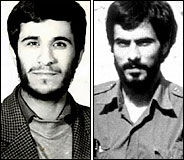
Again, I’m not saying that Mr. Ahmadinejad wasn’t involved in the embassy take over.
Still, it would be nice if the press took a more factual and less
anecdotal approach to this story, as well as Mr. Ahmadinejad’s
background in general. I say this with a few days hindsight, knowing
that the charges were floated, then the story completely disappeared
from the the news. (Sort of reminds you of how the Saddam – al Qaeda
link got started.)
And, if Ahmadinejad actually does have a suspicious past — especially to a tune much worse than the embassy takeover (Kurd Murder Claim Against Iran Leader – link) — wouldn’t it be better to have some solid research and follow-up (like the press used to offer) rather than just the usual innuendo?
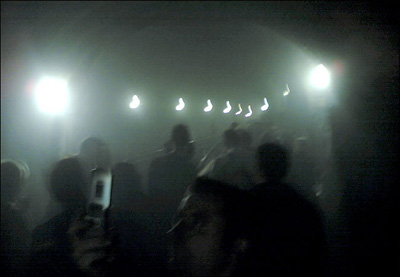
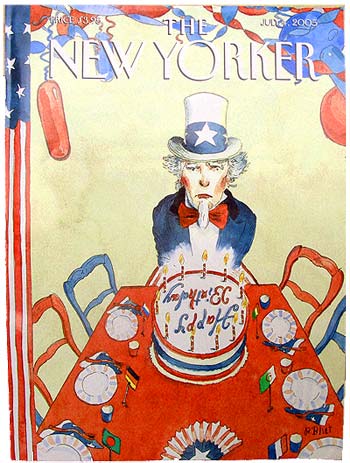
Reactions
Comments Powered by Disqus